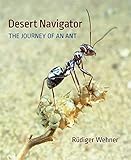Desert navigator: the journey of an ant
Material type: TextLanguage: English Publication details: Cambridge Harvard University Press 2020Description: 392 pagesISBN: 9780674045880 (HB)Subject(s): Ants -- Sahara | Animal navigation | Neural circuitry | Computational Biology
TextLanguage: English Publication details: Cambridge Harvard University Press 2020Description: 392 pagesISBN: 9780674045880 (HB)Subject(s): Ants -- Sahara | Animal navigation | Neural circuitry | Computational Biology BOOKS
List(s) this item appears in:
evolution
BOOKS
List(s) this item appears in:
evolution
| Current library | Home library | Call number | Materials specified | Status | Date due | Barcode |
|---|---|---|---|---|---|---|
| IMSc Library | IMSc Library | 592 WEH (Browse shelf (Opens below)) | Checked out to Arnab Pal (arnabpal) | 09/04/2023 | 75354 |
Includes bibliographical references and index.
Setting the scene -- The thermophiles -- Finding directions -- Estimating distances -- Integrating paths -- Using landmarks -- Organizing the journey.
"How does a small-brained ant living in the Sahara desert know where it is when searching for prey in the vast expanse of sand and gravel? In Desert Navigator Rudiger Wehner describes and illustrates, in a lively and lucid narrative, how the ants accomplish their navigational tasks by using visual cues in the sky that humans are unable to see, the Earth's magnetic field, the direction of the wind, a step counter, an optic-flow meter and path integrator as well panoramic 'snapshots' of their landmark surroundings, and how they combine all this information to optimally steer their courses. Moreover, a glimpse into the navigator's brain reveals the kind of neural circuitry mediating the observed behavior. Truly, the desert ants have now become model organisms in the study of animal navigation. In telling this discovery story, which he enriches by frequent excursions to other animals and even humans, the author lets us participate in the joys and challenges experienced on a fascinating journey to the desert navigator"--
English


There are no comments on this title.